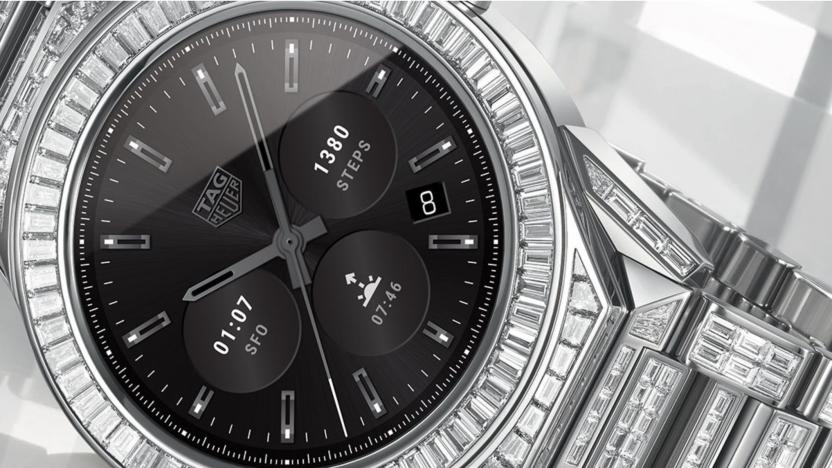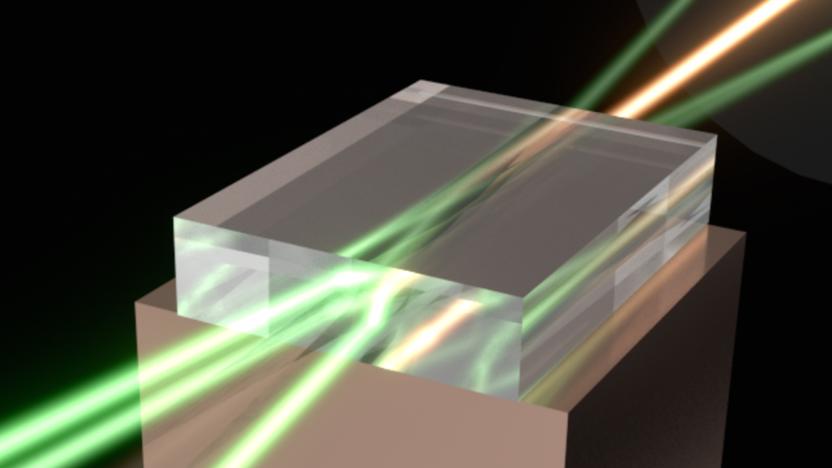diamond
Latest

AI-guided material changes could lead to diamond CPUs
Scientists know that you can dramatically alter a crystalline material's properties by applying a bit of strain to it, but finding the right strain is another matter when there are virtually limitless possibilities. There may a straightforward solution, though: let AI do the heavy lifting. An international team of researchers has devised a way for machine learning to find strains that will achieve the best results. Their neural network algorithm predicts how the direction and degree of strain will affect a key property governing the efficiency of semiconductors, making them far more efficient without requiring educated guesses from humans.

FBI reportedly carried out a sting operation on Huawei at a burger joint
The makers of a super-hard smartphone glass made partially of synthetic diamonds took part in an FBI sting on Huawei, according to a new Bloomberg report. The operation apparently took place at a Prime Burger joint in Vegas during CES last month, while a Businessweek reporter watched from a nearby gelato stand. The embattled Chinese company had ordered samples of the "Miraj Diamond Glass" from US startup Akhan Semiconductor in 2017, only to return them badly damaged. Suspecting Huawei of intellectual property theft, Akhan's founder Adam Khan reportedly contacted the FBI, which drafted him and COO Carl Shurboff to take part in its Huawei investigations.

'Pokémon Go' gets a little bigger with 'Diamond' and 'Pearl' monsters
The Pokémon Company has announced that monsters from the Sinnoh region -- the Diamond and Pearl games -- are now available in Pokémon Go. Players will now be able to capture favorites like Turtwig, Chimchar and Piplup as they make their debut in the still-popular mobile AR game.

Diamond 'guitar' strings could lead to quantum computer memory
Quantum computers need memory to perform tasks like their conventional counterparts, but it's hard to create that memory when it only takes nearby vibrating atoms to lose all their data. Scientists may have a clever solution, though: tune diamond like a guitar string. They've crafted a quantum memory system where micron-wide diamond crystal strings house impurities that are better suited to data-storing electrons. If you subject the diamond to a voltage, you can stretch it and boost the frequencies the electrons are sensitive to, much like you would tighten a guitar string to change its pitch. It'll be harder to disturb the data, in other words.

TAG Heuer covered its smartwatch in real diamonds
If you like your tech on the bling side, we've got good news for you. Watchmaker TAG Heuer has revamped its 18K white gold Connected Modular 45 smartwatch with no less than 589 baguette-sized diamonds -- 23.35 carats' worth in fact -- and it can be yours for a mere $197,000 (£143,000). The watch, which takes the title of most expensive smartwatch in the world, is basically just last year's $1,600 Connected Modular 45 with a makeover. Underneath all the ice is the same Android 2.0 device with the same tech. And while there was surprising demand for the original when it first came out, something tells us that the Full Diamond model won't see quite the same level of sales.

Recommended Reading: Japan's eSports struggle
The Crazy Laws Keeping Japanese Out of Video Game Competitions Yuji Nakamura and Takako Taniguchi, Bloomberg Japan is a popular locale for video games, but laws are keeping eager players from participating in the eSports revolution. Bloomberg has the details on how regulations aimed at gambling and organized crime make paid gaming competitions impossible.

Scientists recreate Neptune's diamond rain using powerful lasers
While we've yet to fully explore Neptune and its fellow gas giants, scientists have a lot of theories about them based on the info we know. For instance, they believe that it rains diamonds on those planets -- diamonds that sink into their interior and form a sparkly crust around their solid cores. Since it might take a long time before we can study our gas giants more closely, a team of researchers have decided to take matters into their own hands. They recreated Neptune's conditions at Stanford's SLAC Laboratory and successfully observed the formation of diamond rain, thanks to the help of some very powerful lasers.

Silicon-laced diamonds could lead to practical quantum computers
Scientists already believe that diamonds could be a solid foundation for practical quantum computers. You can use atom-scale defects in diamond to store quantum bits that hold contradictory data (say, both on and off) in a way that lets you read the data without the risk of changing it. But there's a problem. The most common defect, where nitrogen atoms replace carbon atoms, emits such a broad range of light that it's too inaccurate to be useful. However, a team of researchers may have a way to keep those inaccuracies to a minimum: slip in some silicon, which emits a much narrower range of light.

Death Star-like lasers become a practical reality
Like many elements of sci-fi, the superweapon in Star Wars' Death Star seems implausible: can you really combine multiple laser beams into one fearsome blast? Apparently, you can... if not quite as dramatically as you see in the movies. Scientists have developed a technique that uses diamond to merge multiple laser beams into more powerful ones. The key was to put an exceptionally pure diamond at the point where the beams converge, taking advantage of the crystal's inherent tendency to send the light's power in a specific direction. The material is good at shedding excess heat, too, which is rather important when you're funneling a lot of laser power into a small space.

Diamonds convert nuclear waste into clean batteries
Nuclear waste is normally a major environmental headache, but it could soon be a source of clean energy. Scientists have developed a method of turning that waste into batteries using diamond. If you encapsulate short-range radioactive material in a human-made diamond, you can generate a small electrical charge even as you completely block harmful radiation. While the team used a nickel isotope for its tests, it ultimately expects to do this using the carbon isotope you find in graphite blocks from nuclear power plants.

Nano-sized diamond thread may be a super-strong wonder material
Move over, graphene -- you're not the only miracle material in town. Australian researchers have discovered that diamond nanothreads (one-dimensional diamond crystals capped with hydrogen) could be extremely strong. While scientists thought they were brittle when announced just a month ago, it turns out that they become supremely flexible (and thus durable) when you introduce the right kinds of defects. You could create nanoscopic structures that are just as strong as you need them to be, with a 'perfect' mix of bendy and rigid shapes.

Astronomers discover Earth-sized 'diamond' 900 light years away
The world's largest diamond, the Cullinan, is a tad over 3,100 carats uncut. Its estimated value is some $2 billion, and it only weighs about 1.37 pounds. That stone, while enormous relative to others like it, is but an invisible speck when up against the Earth-sized diamond discovered 900 light years from our planet. PSR J2222-0137, a pulsating companion to a white dwarf star located near the constellation Aquarius, has an incredibly low temperature of about 5,000 degrees Fahrenheit. It's the coldest such object that astronomers have ever detected -- so cool, in fact, that it's likely composed of crystallized carbon, much like the diamonds we treasure so greatly. Ultimately, while an exciting development, it would take 10 lifetimes traveling at the speed of light to reach this interstellar discovery, so don't expect an influx of those coveted clear jewels anytime soon. [Image credit: B. Saxton, NRAO/AUI/NSF]

Diamond hones DOE X-ray laser howitzer to razor-sharp precision
The US Department of Energy's SLAC accelerator lab already has a pretty useful X-ray laser -- the Linac Coherent Light Source (LCLS). But, recent modifications to the device have scientists drooling over its new found potential. Using a thin wafer of diamond, the Stanford-run lab filtered the beam to a lone frequency, then amplified it in a process called "self-seeding." That's given the world's most powerful X-ray laser even more punch by tossing out unneeded wavelengths which were reducing its intensity. The tweaks allow scientists across many fields to finesse and image matter at the atomic level, giving them more power to study and change it. According to the lab, researchers who came to observe the experiment from other X-ray laser facilities "were grinning from ear to ear" at the possibility of integrating the tech into their own labs. The SLAC team claims they could still add 10 times more punch to the LCLS with further optimization, putting the laser in a class by itself -- X-ray-wise, anyway.

Flawed diamonds are perfect ingredients for quantum computing, just add time travel
Ready to suspend your brain cells in a superposition of disbelief? Good, because the latest news published in Nature is that diamonds are a quantum computer's best friend -- particularly if they're flawed. An international team of scientists sought out sub-atomic impurities in a 1mm-thick fragment of over-priced carbon and used these as qubits to perform successful calculations. A "rogue" nitrogen nucleus provided one qubit, while a free electron became a second. Unlike previous attempts at solid-state quantum computing, this new effort used an extra technique to protect the system from decoherence errors: microwave pulses were fired at the electron qubit to "time-reverse" inconsistencies in its spinning motion. Don't fully get it? Us neither. In any case, it probably won't stop jewellers tut-tutting to themselves.

Mouse Computer's LuvBook S heals emotional scars, one Hello Kitty at a time
What the world needs now is just one thing, and that thing is a bejeweled Hello Kitty laptop. Fortunately, Japan's Mouse Computer is well aware of this, which is why it's unleashed the LuvBook S, pictured above. Designed in collaboration with Sanrio and Swarovski, this masterpiece is powered by a 2.2 GHz Intel Core i3-2330M processor and boasts an 11.6-inch, 1,366 x 768 display. It also packs a 500GB HDD and a 1.3 megapixel camera, but all that really matters is the swaggy centerpiece -- a heart-ensconced Hello Kitty mug made out of about 1,100 Swarovski stones and untold buckets of cuddles. The LuvBook is available now for ¥69,930 (about $900), at the source link below.

Iced out 24-carat gold MacBook Pro proves diamonds are an Apple's best friend
Computer Choppers' latest luxury overhaul is about as Cribs-worthy a laptop as we've ever laid our hard-working eyes on. Just like this 24-carat stunner before it, the shiny setup gives something a little extra to that Apple logo, by way of Marilyn's favorite gems, but sets itself apart with the addition of a rather unexciting paisley pattern. If you're the type who flushes hundos, though, you can ditch the paisleys for your very own custom design. As is often the case with these things, the price isn't listed, but frankly, we'd hold out until they replace those black plastic chiclets with something fit for the Diamond Princess.%Gallery-136095%

Iced-out diamond planet catches astronomers' eyes
If you thought Kim Kardashian's engagement ring was a ridiculous rock, you haven't seen the ludicrously large diamond planet, J1719-1438. Scientists at the Swinburne University of Technology in Melbourne recently spotted this celestial body that's so dense, it's believed to be crystalline carbon -- i.e. a ginormous diamond similar in size to Jupiter. Since the '60s, astrophysicists like Marc Kuchner have theorized that carbon-heavy stars can burn out, crystallize and form diamonds under the right pressure. Supporting the idea, a white dwarf star spotted in 1992, BPM 37093, had cooled and crystallized over the course of 12 years -- even copping the nickname "Lucy" after the Beatles jam. Although astronomers in Australia, Britain and Hawaii have all identified the newly spotted precious planet J1719-1438, they are still unsure if the crystallized carbon rock will be all sparkly mountains up close -- dashing the hopes and dreams of material girls everywhere.

Gresso flaunts $30,000 white iPhone 4, holds more ice than a skating rink
Sure, you probably waited longer than you should have to get the elusive white iPhone 4. But, you know what's better than a boring regular model? One with diamonds, crystals and pearls... of course! Known for its ridiculous custom mobile devices, Gresso may force you to refinance your house and hock a kidney to afford its latest creation, the Lady Blanche. A solid diamond-coated mineral glass backing, three independent Swiss clocks and pearl dials replace the usual body on this iced-out iPhone. If the $30k diamond model is a bit out of your price range, the much more affordable Swarovski crystal version will only set you back 7,000 bones. Release details are unclear at this point, but when they drop you better act fast -- only 150 of these gems will be available. Heck, if you have that kind of cash lying around, just get the salesman to throw in one of these for your iPad, too.

Vertu Signature Precious is awash in sea of sapphire...and regret (video)
It may not feature GPS, an accelerometer, or even a camera, but if you've run out of disposable items to encrust with jewels, then Vertu's Precious -- the latest revision to its aging Signature lineup -- may be the mobile phone for you. While its basic array of quadband GSM, 2100 / 850 MHz 3G, Bluetooth and WiFi may seem a touch modest, varieties come slathered in platinum, three types of gold (yellow, white and red), leather, ceramic, and enough jewels to make Her Majesty blush. Its face, known as the "sea of sapphire," is mostly obscured (save for the OLED display), but you high rollers can take comfort knowing it spent more than two weeks in a 2000°C oven to appease your discerning taste. Also hidden are 4.75 carats of ruby bearings, which are said to give the keys a frictionless, satisfying click. The ring tones are exclusive compositions by Dario Marianelli and performed by the London Symphony Orchestra -- though we were bigger fans before they sold out. For a quick glimpse of how the Precious comes together gem by gem, just follow the break. There's no word on pricing or availability, but if you're considering putting up your first born as collateral, you might want to reconsider this cringe-worthy creation. [Thanks, Radi]

Rumor: Xbox LIVE Diamond TV service to be announced at E3
With E3 set to kick off in less than 48 hours, rumors are once again flying about Microsoft's press conference news. A report at WinRumors pins Microsoft as revealing an Xbox Live-based streaming television service in the US, previously rumored to be codenamed "Orapa" (after a diamond mining town in Botswana, Africa). Further, the report suggests that the codename has been changed into something more fitting, given its eponymy: "Diamond." And no, not that Microsoft product named Diamond. "Microsoft is currently in last minute negotiations to secure the necessary agreements in time," WinRumors' anonymous source added. The source details "Diamond" as a facsimile of the UK's SkyTV player currently offered on Xbox 360, though no specific networks are named, and adds that the service will likely come with a monthly subscription fee. Microsoft previously indicated its intentions to get into streaming television on the Xbox 360, but has never made any major moves. The company flirted with a Conan O'Brien deal in 2010, but the plans eventually fizzled. If "Diamond" really does exist, though, we're sure to hear about it tomorrow morning during Microsoft's E3 2011 presser.












